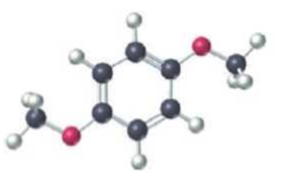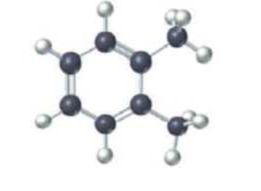
Fundamentals of General, Organic, and Biological Chemistry Plus Mastering Chemistry with Pearson eText -- Access Card Package (8th Edition)
8th Edition
ISBN: 9780134033099
Author: John E. McMurry, David S. Ballantine, Carl A. Hoeger, Virginia E. Peterson
Publisher: PEARSON
expand_more
expand_more
format_list_bulleted
Textbook Question
Chapter 13, Problem 13.27UKC
Draw the product from reaction of the following substances with (1) Br2 and FeBr3 and (2) SO3 and H2SO4 catalyst (red = O):
(a) 
(b) 
Expert Solution & Answer
Want to see the full answer?
Check out a sample textbook solution
Students have asked these similar questions
For the following reaction, 4.91 grams of water are mixed with excess chlorine gas. The reaction yields 12.5 grams of hydrochloric acid.chlorine (g) + water (l) hydrochloric acid (aq) + chloric acid (HClO3) (aq)
What is the theoretical yield of hydrochloric acid ?
grams
What is the percent yield of hydrochloric acid ?
%
The standard heat of combustion of liquid methyl cyclopentane, C6H12(l),C6H12(l), was measured to be −3937.7 kJ/mol.−3937.7 kJ/mol. What is Δ?̂ ∘f C6H12(l),ΔH^f C6H12(l)∘, the standard heat of formation of liquid methyl cyclopentane?
If the phosphorus atom in 3-phosphoglycerate is radioactively labeled, where will the label be when the reaction that forms 2-phosphoglycerate is over?
Chapter 13 Solutions
Fundamentals of General, Organic, and Biological Chemistry Plus Mastering Chemistry with Pearson eText -- Access Card Package (8th Edition)
Ch. 13.2 - Prob. 13.1PCh. 13.2 - Prob. 13.2PCh. 13.2 - What are the IUPAC names of the two alkenes shown...Ch. 13.3 - Prob. 13.4PCh. 13.3 - Prob. 13.5PCh. 13.3 - Prob. 13.6KCPCh. 13.5 - Prob. 13.7PCh. 13.5 - Many biological transformations can be simply...Ch. 13.5 - (a) After the reaction of 11-cis-retinal with...Ch. 13.5 - Prob. 13.2CIAP
Ch. 13.5 - Prob. 13.3CIAPCh. 13.6 - Prob. 13.9PCh. 13.6 - Prob. 13.10PCh. 13.6 - Prob. 13.11PCh. 13.6 - Prob. 13.12PCh. 13.6 - Prob. 13.13PCh. 13.6 - Prob. 13.14KCPCh. 13.6 - Prob. 13.1MRPCh. 13.6 - Prob. 13.2MRPCh. 13.6 - Prob. 13.3MRPCh. 13.7 - Prob. 13.15PCh. 13.7 - Prob. 13.16PCh. 13.8 - Prob. 13.17PCh. 13.8 - Polychlorotrifluoroethylene (PCTFE (Kel-F)) is a...Ch. 13.9 - Prob. 13.19PCh. 13.9 - Prob. 13.20PCh. 13.9 - Prob. 13.21KCPCh. 13.10 - What products will be formed when toluene is...Ch. 13.10 - Prob. 13.23PCh. 13.10 - Prob. 13.4CIAPCh. 13.10 - Prob. 13.5CIAPCh. 13.10 - Prob. 13.6CIAPCh. 13 - Prob. 13.24UKCCh. 13 - Prob. 13.25UKCCh. 13 - Prob. 13.26UKCCh. 13 - Draw the product from reaction of the following...Ch. 13 - Prob. 13.28UKCCh. 13 - Prob. 13.29UKCCh. 13 - Prob. 13.30APCh. 13 - Prob. 13.31APCh. 13 - What family-name endings are used for alkenes,...Ch. 13 - Prob. 13.33APCh. 13 - Prob. 13.34APCh. 13 - Write structural formulas for compounds that meet...Ch. 13 - Prob. 13.36APCh. 13 - Prob. 13.37APCh. 13 - Draw structures corresponding to the following...Ch. 13 - Draw structures corresponding to the following...Ch. 13 - Seven alkynes have the formula C6H10. Draw them,...Ch. 13 - Prob. 13.41APCh. 13 - Prob. 13.42APCh. 13 - There are four different pentenes having the...Ch. 13 - Prob. 13.44APCh. 13 - Prob. 13.45APCh. 13 - Draw line structures for the following alkenes....Ch. 13 - Which compound(s) in Problem 13.43 can exist as...Ch. 13 - Prob. 13.48APCh. 13 - Prob. 13.49APCh. 13 - Which of the following pairs are isomers, and...Ch. 13 - Prob. 13.51APCh. 13 - Prob. 13.52APCh. 13 - Prob. 13.53APCh. 13 - Prob. 13.54APCh. 13 - Prob. 13.55APCh. 13 - Prob. 13.56APCh. 13 - Prob. 13.57APCh. 13 - Prob. 13.58APCh. 13 - Prob. 13.59APCh. 13 - What alkene could you use to make the following...Ch. 13 - Prob. 13.61APCh. 13 - Prob. 13.62APCh. 13 - Prob. 13.63APCh. 13 - Prob. 13.64APCh. 13 - For each of the following reagents, decide whether...Ch. 13 - Prob. 13.66APCh. 13 - Prob. 13.67APCh. 13 - Prob. 13.68APCh. 13 - Salicylic acid (o-hydroxybenzoic acid) is used as...Ch. 13 - The following names are incorrect by IUPAC rules....Ch. 13 - Prob. 13.71CPCh. 13 - Prob. 13.72CPCh. 13 - Prob. 13.73CPCh. 13 - Prob. 13.74CPCh. 13 - Menthene, a compound found in mint plants, has the...Ch. 13 - Prob. 13.76CPCh. 13 - Prob. 13.77CPCh. 13 - Two products are possible when 2-pentene is...Ch. 13 - Ocimene, a compound isolated from the herb basil,...Ch. 13 - Describe how you could prepare the following...Ch. 13 - Which of the following compounds are capable of...Ch. 13 - Prob. 13.82GPCh. 13 - Superglue is an alkene polymer made from the...Ch. 13 - Draw all possible C5H10 alkene isomers having a...
Knowledge Booster
Learn more about
Need a deep-dive on the concept behind this application? Look no further. Learn more about this topic, biochemistry and related others by exploring similar questions and additional content below.Similar questions
- Where in the periodic table are the best reducing agents found? The best oxidizing agents?arrow_forwardTwo solutions, 250.0 mL of 1.00 M CaCl2(aq) and 250.0 mL of 1.00 M K2SO4(aq), are combined, and the temperature decreased by 2.40 degrees C. Determine qrxn per mole of CaSO4(s) formed in the reaction. A) +12.0 kJ/mol B) -12.0 kJ/mol C) +6.00 kJ/mol D) -6.00 kJ/molarrow_forwardwhich statement is true for the following reaction?arrow_forward
- In the electrolysis of aqueous sodium bromide, there are two possible anodic reactions: *2H2O(l) ——-> 02(g) + 4H+(aq) + 4e–, E° = 1.23V2Br–(aq) ——–> Br2(g) + 2e-2, E° = 1.08 VWhich reaction occurs at anode and why?arrow_forwardDraw all possible carboxylic acids with the formula C5H10O2.arrow_forwarddraw the alkane strucutre based off the IR spectrum, 1H NMR spectrum, and 13C NMR spectrum for this compound.arrow_forward
- For the following reactions, identify the atom(s) being oxidized and reduced:arrow_forwardThe formation constants at 25°C for Fe(CN)4-6 and Fe(EDTA)2– are 1.00 x 1037 and 2.10 x 1014, respectively. Answer the questions below. 1) Calculate K under standard conditions for the reaction Fe(EDTA)2−(aq) + 6CN−(aq) ----> Fe(CN)4−6(aq) + EDTA4−(aq) 2) Calculate ΔG° for the reaction. (kJ/mol)arrow_forwardIn the preparation of aspirin, You can do the functional group test to ensure the completion of the reaction. (a) What is the name of reagent used? (b) What is your observation if any unreacted starting material is present? (c) What is the name of the functional group responsible for this reaction?arrow_forward
- Arrange the following compounds in the increasing order of their boiling points :CH3CHO, CH3CH2OH, CH3OCH3, CH3COOH.arrow_forwardIf you measured the rate of reaction at 20°C to be 1.11 x 10-5 M/s when using 0.080 M I1- and 0.040 M S2O82-. Approximately how long will the reaction take if you were to increase the temperature to 30 °C?arrow_forwardCalculate ΔG for the reaction H2O(l) ⇆ H+(aq) + OH−(aq) at 25°C for the following conditions. [H+] = 3.1 M, [OH−] = 4.7 ×10−4 Marrow_forward
arrow_back_ios
SEE MORE QUESTIONS
arrow_forward_ios
Recommended textbooks for you

GCSE Chemistry - Acids and Bases #34; Author: Cognito;https://www.youtube.com/watch?v=vt8fB3MFzLk;License: Standard youtube license